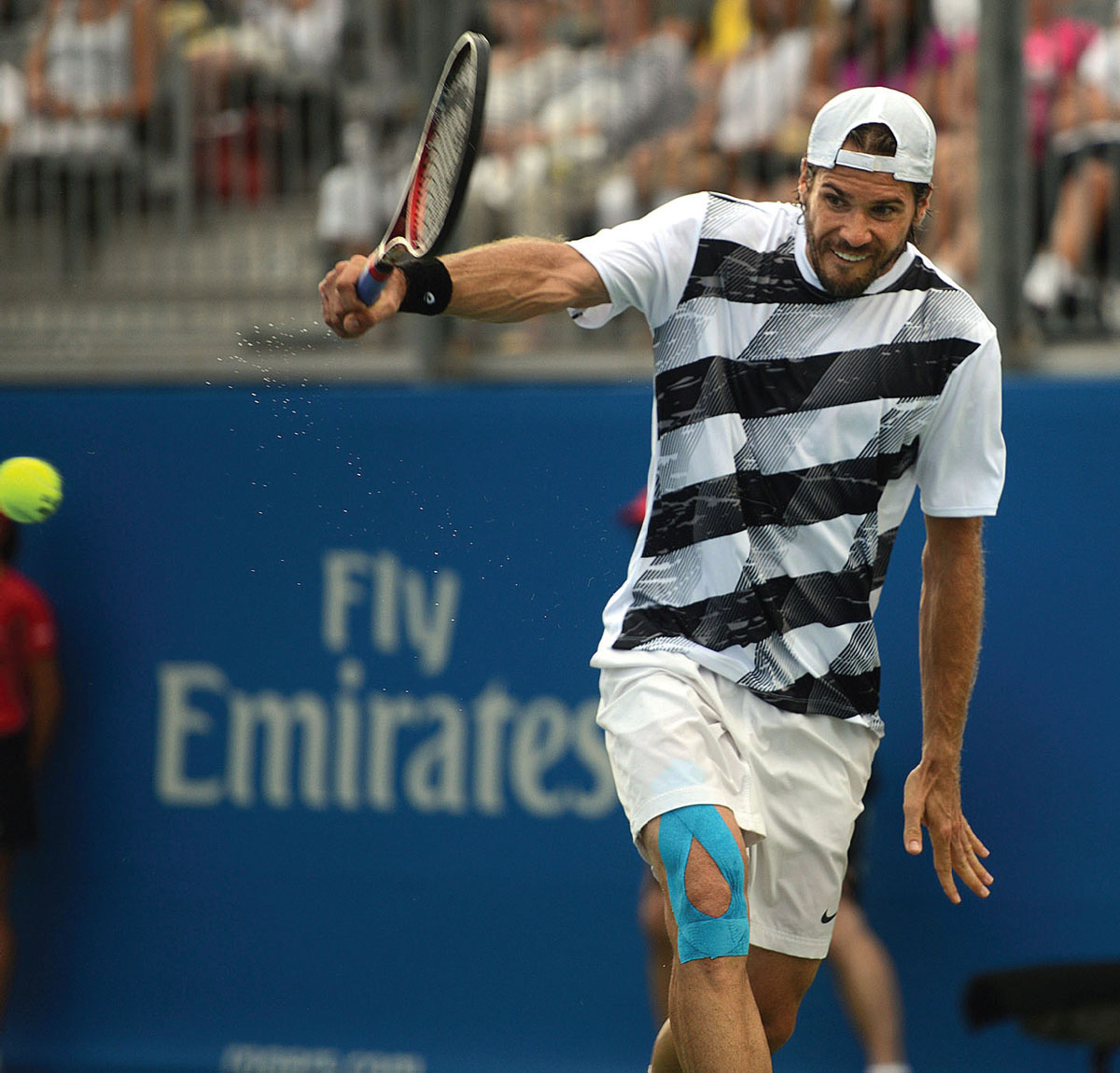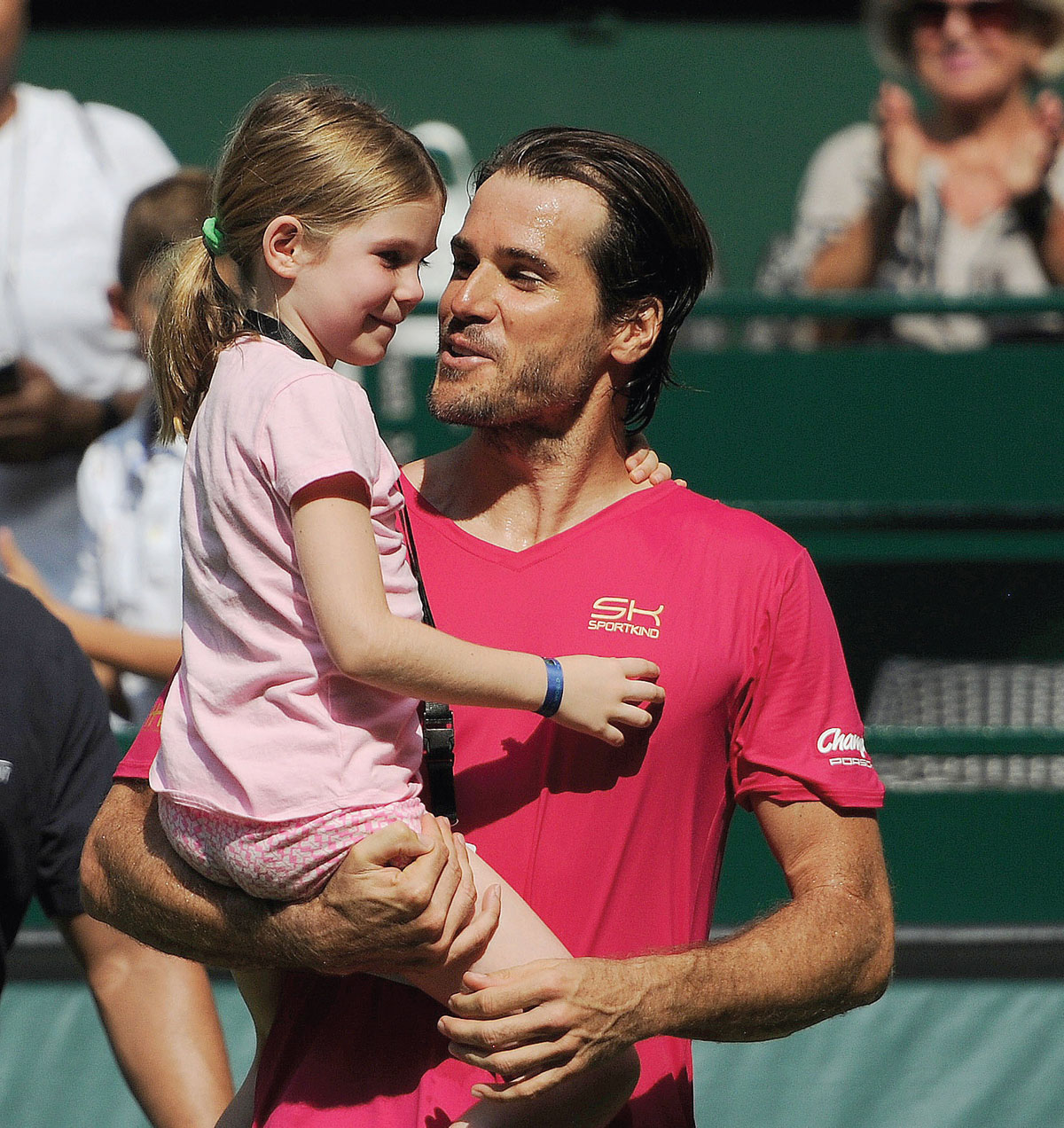
Tommy Haas
“You can’t lose it. Fight!”—Tommy Haas
Tommy Haas never gives up. You’ve got to admire him for that. His extraordinary tenacity is a big part of the story. In a March 2017 New Yorker story about the future of tennis, Louisa Thomas began: “Tommy Haas, the thirty-eight-year-old German tennis player, was once one of the top players on the A.T.P. tour; he is now one of the oldest.”
Haas, born in Germany, is a dual German and American citizen who plays tennis under the German flag, although he often identifies as an American. He lives in Los Angeles and Sarasota, Florida. He is married to the actress Sara Foster, daughter of David Foster, the Canadian composer and record producer (Sara is a friend of Mirka Federer; Tommy and Roger are also friends). He has two young daughters who he says are his inspiration. His idol has always been another German tennis player, Boris Becker. Haas is one of a handful of players who have kept the old-fashioned, elegant, one-handed backhand.
Tommy Haas’s breakthrough was more than twenty years ago, in 1997, a year after he turned professional, at the age of nineteen. Haas, who finished the year ranked No. 45, had a spectacular early career. In 1998 he beat Andre Agassi at Wimbledon in the second round. The following year, he advanced to the Australian Open semifinal, defeating Lleyton Hewitt in the second round. In 2000 he beat Federer in the semifinals of the Sydney Olympics and won a silver medal. Two years later, he reached his highest ranking ever, No. 2 in the world, despite family tragedy. In June 2002 his parents were in a serious motorcycle accident, riding a Harley-Davidson that he had given them; his father suffered permanent brain damage.
Since 2002, it has been hard going for Haas, a long downward slide propelled by injuries (shoulder, rotator cuff, elbow, ankle, hip, and foot, with nine surgeries in all), punctuated by announcements of imminent retirement but also by unexpected and gratifying victories. He missed the entire 2003 season. In 2004 he was named ATP Comeback Player of the Year, but he didn’t get back into the Top 10 until 2007. After a successful 2009, he missed almost eighteen months in 2010 and 2011. He started 2012 ranked 205 and ended it ranked 25, the oldest player inside the Top 50; once more, he was named Comeback Player of the Year (besides Haas, only del Potro has been named Comeback Player twice).

Haas’s one-handed backhand was considered one of the most elegant strokes on the ATP Tour.

In 2012 Haas didn’t even have a steady clothing contract, using various outfits and changing them during matches.
In 2013, he finished at No. 12. This included a victory over Novak Djokovic in March at Key Biscayne, where he became the oldest man in thirty years to defeat a No.1 player. In 2014, he retired from play four times because of a shoulder injury, ending the year as No. 77. Then Tommy Haas pretty much disappeared, until his surprising reemergence in 2017.
Haas’s career has been one of setbacks. He doesn’t always deal with disappointment with equanimity. Christopher Clarey in the New York Times has written that he has “a deeply ingrained negative streak, a tendency to gripe and snipe at his coaches and support team under pressure, and a propensity for finding fault with elements beyond his control.”
Haas has said that 2017 was his last year as a professional player. It was a farewell tour. It was his final comeback. He says he wanted to finish “on my own terms.” He wanted his older daughter, Valentina, to be able to watch him play. “I would love to see [her] sit in my box the next few months and watch her daddy play and realize what I’m doing and really remember that for the rest of her life.” He’s thirty-nine, the same age as Jimmy Connors when he stopped playing on the tour. Now Haas will concentrate on his new job, tournament director of Indian Wells.
He started 2017 ranked No. 1,028. At the Australian Open, in January, suffering from breathing difficulties, he retired from his first-round match against No. 48 Benoît Paire. At Delray Beach, in February, he lost his opening-round singles match to No. 87 Nikoloz Basilashvili. At the Miami Open in March, he again lost in the first round, to No. 54 Jiří Veselý. (His game against Veselý was temporarily stopped when a wild iguana invaded the tennis court.) Then in April, at Monte Carlo, to general surprise and satisfaction, things suddenly changed: Haas beat Paire—the 2016 Comeback Player of the Year—in straight sets in just over an hour. The website ATP World Tour commented, “Maybe Tommy Haas should reconsider this whole retirement thing.” Paire’s offensive comment on his opponent? “Le mec est nul.” (“This guy is a nobody.”) And then, something amazing: Haas beat Federer in the second round at Stuttgart in June.

With his daughter Valentina at Halle 2017.

Haas’s on-court intensity was legendary.
Fresh from beating Federer, Haas had a wild card for 2017 Wimbledon. Would something wonderful happen there? It didn’t. He was beaten in the first round by a little-known Belgian, Ruben Bemelmans. The crowd gave Haas a standing ovation. Said Haas, “I’m happy to have somehow made it out on the court and I just have to continue to fight that battle until I know it’s finally done.”
Nothing captures Haas’s spirit better than his famous “chat with himself” at the 2007 Australian Open, where he was playing Nikolay Davydenko in the quarterfinal. Down a service break in the fourth set, Haas was caught on the microphone talking to himself: “You can’t win that way, Haasi. It’s not possible. It doesn’t work that way. It doesn’t work. Just too weak. Too many errors. Too many errors. It is always the same. I don’t want this anymore. I don’t feel like it. Why am I doing all this shit? For what? For whom? Except for myself. Why? For which reason? I can’t do it. I don’t get it. I’m paying people for nothing. For absolutely nothing. That I can get excited over it. You’re a retard. Once again, you didn’t go to the net. Nicely done. But you’re gonna win. You’ll win that match, come on! You can’t lose it. Fight!”
Haas went back on the court and won the next point, as well as the fifth set and the match.